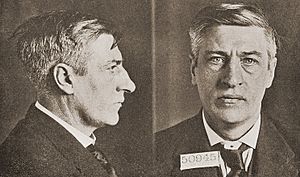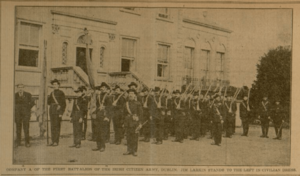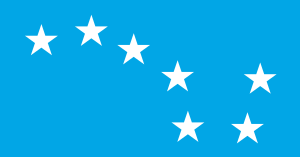Irish Citizen Army facts for kids
Quick facts for kids Irish Citizen Army |
|
|---|---|
| Arm Cathartha na hÉireann | |
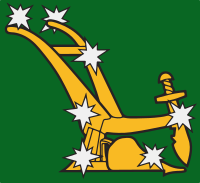
The original Starry Plough flag from 1914, flown during the Easter Rising
|
|
| Leaders |
|
| Dates of operation | 1913–1947 |
| Headquarters | Liberty Hall, Dublin |
| Ideology |
|
| Size |
|
| Allies |
|
| Opponents | British Army Royal Irish Constabulary Dublin Metropolitan Police Industrialists |
| Battles and wars | |
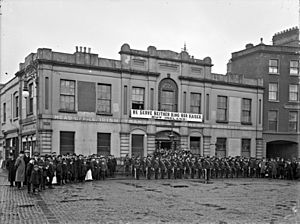
The Irish Citizen Army (ICA), also known as Arm Cathartha na hÉireann in Irish, was a small group of trained volunteers. They were part of the Irish Transport and General Workers' Union (ITGWU). The ICA was formed in Dublin on 23 November 1913. Its main goal was to protect workers during protests from the police.
Key leaders like James Larkin, James Connolly, and Jack White helped create the ICA. Other important members included Constance Markievicz and Kit Poole. In 1916, the ICA took part in the Easter Rising. This was an armed rebellion that aimed to end British rule in Ireland.
After the Easter Rising, James Connolly died and Jim Larkin left Ireland. The ICA became less active during the Irish War of Independence. They mainly offered support to the Irish Republican Army (IRA), but did not fight directly. This led to many members leaving the ICA. During the Irish Civil War, the ICA stayed "neutral." This caused even more members to leave.
The ICA lost its military importance after 1920. There was a brief attempt to revive it in 1934. This happened when the new Republican Congress was formed. However, the Republican Congress soon split apart. The ICA also faded away at that time.
Contents
How the ICA Started: The Great Lockout of 1913
The Irish Citizen Army was formed during a big strike in 1913. This strike was called the Lockout of 1913. It involved the Irish Transport and General Workers Union (ITGWU). The union wanted employers to officially recognize them.
The strike began when a businessman named William Martin Murphy refused to employ union members. In response, James Larkin, who founded the union, called for a strike. This strike affected Murphy's tramway company. Other companies also fired ITGWU members. This was an effort to break the union. Eventually, 400 employers and 25,000 workers were involved.
The strike caused Dublin's economy to almost stop. There were many violent clashes between strikers and the Dublin Metropolitan Police. On 31 August, two men were killed and about 500 were hurt during a rally. Another striker was later killed by a bullet from a strike-breaker.
Because of this violence, Larkin called for a workers' militia. This group would protect workers from the police. During the lockout, the Citizen Army used hurleys (sticks used in hurling, an Irish sport) and bats for protection. Jack White, a former British Army captain, volunteered to train this new army. He also gave money for shoes for the workers. The Army trained in Croydon Park in Fairview. It also gave unemployed workers something to do. After six months, the workers returned to work, defeated and hungry. The ICA's first purpose was over, but it would soon change.
Building a Stronger Army
The Irish Citizen Army was completely reorganized in 1914. In March, police attacked an ICA demonstration. Jack White, their commander, was arrested. Seán O'Casey, a famous writer, suggested the ICA needed a more formal structure.
He wrote a constitution for the Army. It stated that "the ownership of Ireland, moral and material, is vested of right in the people of Ireland." It also said that all differences of background should be forgotten. Everyone should unite under the name of the Irish people.
Larkin insisted that all members must also be part of a trade union. In mid-1914, Jack White left the ICA to join the Irish Volunteers. Larkin then took direct command of the ICA.
The ICA got Mauser rifles from Germany. These were bought by the Irish Volunteers and brought into Ireland at Howth in July 1914. The ICA was one of the first groups to allow both men and women to join. They trained everyone in how to use weapons. The ICA's main base was Liberty Hall, the ITGWU union building. Most members were from Dublin. However, James Connolly also started branches in Tralee and Killarney in County Kerry.
James Larkin left Ireland for America in October 1914. This left James Connolly in charge of the Citizen Army. At first, the ICA was a self-defense group for workers. But Connolly wanted it to be a revolutionary group. He wanted it to create an Irish socialist republic. Connolly had been in the British Army when he was young. He knew a lot about military tactics.
Connolly believed in achieving political change through force. He saw the ICA as a way to do this. The ICA was a small group, with only about 200-300 members.
In October 1915, armed ICA members helped dockers on strike at Dublin port. Connolly was very upset by Irishmen fighting in World War I. He saw it as a war for empires and money. He began openly calling for a rebellion in his newspaper, the Irish Worker. When this paper was banned, he started another called the Worker's Republic.
An armed organisation of the Irish working class is a phenomenon in Ireland. Now, with arms in their hands, they propose to steer their own course, to carve their own future.
—James Connolly, Workers' Republic, 30 October 1915
British officials allowed the ICA to train and carry weapons. They thought stopping them would cause more trouble. A small group of people from the Irish Volunteers were secretly planning a rebellion. They worried Connolly might start something too early with the ICA. So, they asked him to join their secret council. This was to help plan the armed rebellion, which became the Easter Rising.
The Easter Rising of 1916
On Monday, 24 April 1916, 220 members of the ICA took part in the Easter Rising. This included 28 women. They fought alongside a much larger group of the Irish Volunteers. They helped take over the General Post Office (GPO) on O'Connell Street in Dublin.
Michael Mallin, who was Connolly's second-in-command, led an ICA group. With Kit Poole and Constance Markievicz, they took over St Stephen's Green. Another group, led by Sean Connolly, took over City Hall. They also attacked Dublin Castle. A small group also took over Harcourt Street railway station.
ICA members were among the first rebels to be hurt in the Rising. Two were killed during an attack on Dublin Castle. Sean Connolly, an ICA officer, was the first rebel to kill a British soldier. He was also the first rebel to be killed in the Rising.
Eleven Citizen Army members were killed during the Rising. Five died near City Hall and Dublin Castle. Five died in St Stephen's Green, and one at the GPO.
James Connolly was made the commander of the rebel forces in Dublin. He gave the order to surrender after a week of fighting. He and Michael Mallin were executed by a British Army firing squad a few weeks later. The ICA members who survived were sent to prisons in England or Wales for several months.
Quiet Years: War of Independence and Civil War
War of Independence
After the Easter Rising, the ICA lost many of its strong leaders. James Connolly and Michael Mallin were executed. Jim Larkin was in America and later in prison. The ICA was mostly led by James O'Neill.
During the Irish War of Independence, there were never more than 250 active ICA members. Most of them were in Dublin. At this time, the ICA did not fight British forces directly. Instead, they supported the IRA. They provided weapons, medical help, and other supplies.
In July 1919, the ICA decided that members could only belong to either the ICA or the IRA. This made many members unhappy. A lot of people chose to join the IRA instead.
In April 1919, the ICA chose not to get involved in the Limerick Soviet. This was a local workers' government that was set up. Some members became frustrated with the ICA's lack of action. In January 1920, members argued about their relationship with Sinn Féin and the IRA. Some felt the ICA was just following Sinn Féin. They thought supporting the IRA was wrong because the IRA was not fighting for the same "Workers' Republic" the ICA wanted.
As 1920 went on, the ICA continued military drills. But in reality, it became more like a social club for Dublin's workers and socialists. Members noted that they spent a lot of time playing cards, taking classes on socialism, and running a pipe band.
Civil War
After the Anglo-Irish Treaty was signed, the ICA decided to be "neutral." This was during the Irish Civil War. The ICA believed that neither side was working towards a "Workers' Republic." This was the ICA's main goal. Their view was similar to the main labour movement, which wanted peace.
However, this led to arguments within the ICA. Different groups wanted to follow different leaders. Some wanted to follow Jim Larkin. Others supported Roddy Connolly and his new Communist Party of Ireland. Some wanted the ICA to stay aligned with the main Labour Party.
In the end, most members chose to support the Labour Party. They campaigned for peace between the two sides. This caused many members to leave the ICA. Most joined the Anti-Treaty IRA. A smaller number joined the new National Army of the Free State.
Later Years and Legacy
In the 1920s and 1930s, the ICA continued to exist. It was kept alive by veterans like Seamus McGowan and Dick McCormack. It mostly became a group for old friends who had fought in the Easter Rising. Uniformed ICA members formed a guard of honor at Constance Markievicz's funeral in 1927.
In 1934, the ICA was briefly revived. This happened when Peadar O'Donnell and other left-wing republicans left the IRA. They formed the Republican Congress. They wanted the ICA to be the armed part of their new movement. In 1935, the revived Citizen Army had about 300 members across the country. New leaders like Frank Ryan helped make it stronger.
The ICA and Republican Congress believed in a "triple alliance" for revolution. They thought success would come from three united forces: an armed group (the ICA), a socialist party (the Republican Congress), and one big union (the ITGWU).
However, the Republican Congress split in September 1934. This also caused a split in the ICA. One group left the Congress. The other group remained loyal to the Congress.
The ICA's last public appearance was at the funeral of its founder, James Larkin, in Dublin in 1947.
Uniforms and Banners
The ICA uniform was dark green. It included a slouched hat with a badge shaped like the Red Hand of Ulster. Many members could not afford a full uniform. So, they wore a blue armband. Officers wore red armbands.
Their main banner was the Starry Plough. James Connolly said this flag meant that a free Ireland would control its own future, "from the plough to the stars." The first design of the flag showed a plough with a sword as its blade. This idea came from the Bible. It also showed the socialist belief that war would end when workers united worldwide. This flag was flown by the ICA during the 1916 Rising.
The design of the flag changed in the 1930s. The new design was a blue banner. It was created by members of the Republican Congress. This new design became the symbol of the Irish Labour movement, including the Irish Labour Party. It is also used by Irish republicans. It has been carried alongside the Irish tricolour and Irish provincial flags at many rallies and marches.
Images for kids
-
Statue of ICA leader James Larkin next to the GPO, HQ of the ICA during the Easter Rising



